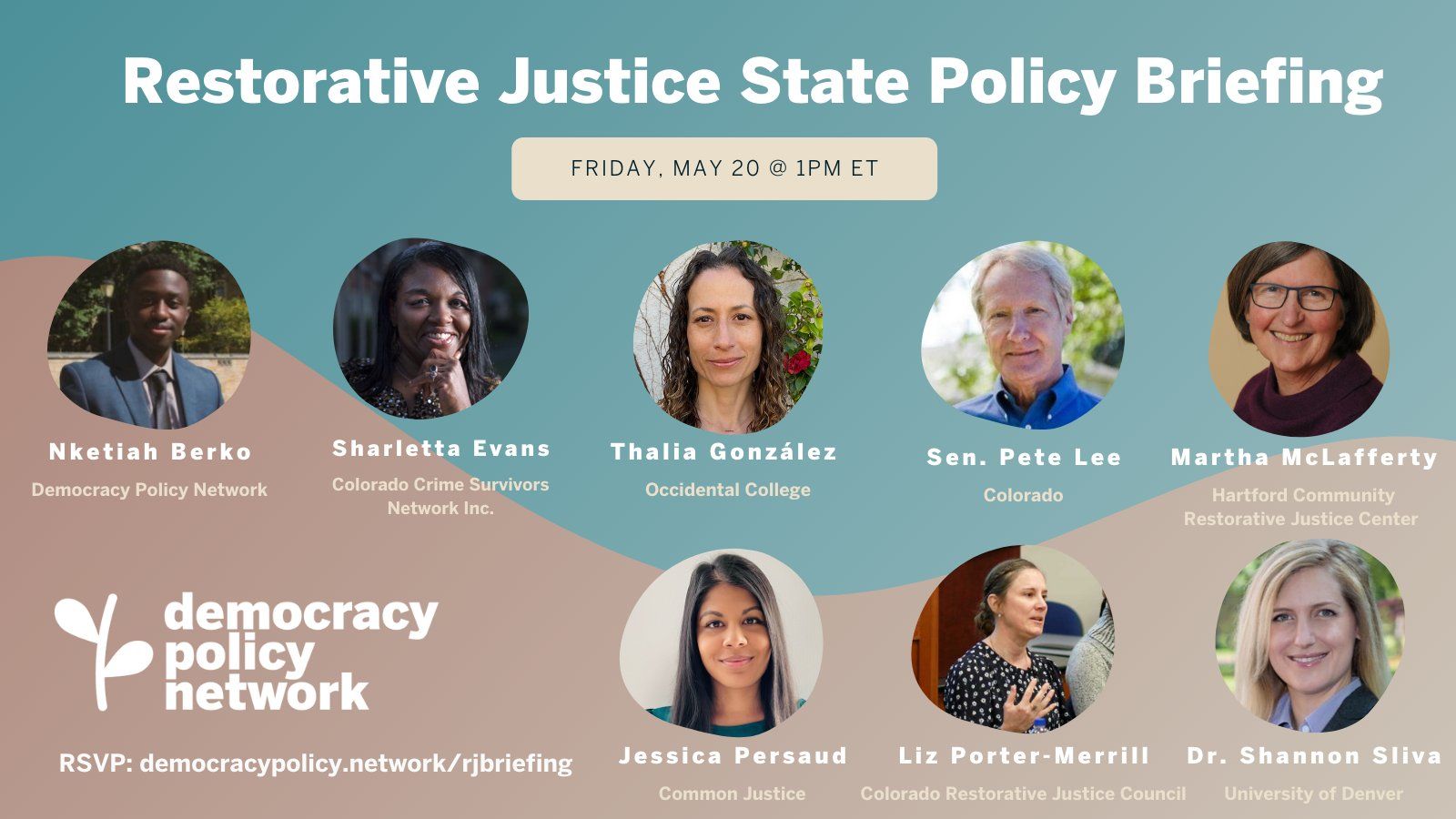🕊 Restorative Justice State Policy Briefing: Video and Notes

On May 20, DPN hosted a state policy briefing on Restorative Justice with experts, advocates, practitioners and legislators at the cutting edge of promoting a greater integration of and financial support for restorative justice processes throughout state criminal legal systems. The briefing was hosted by Nketiah Berko, author of DPN's Restorative Justice state policy kit. Video and notes from the event are below.
Welcome Intro - Nketiah Berko (Policy Organizer, DPN)
- Nketiah is the author of DPN's Restorative Justice state policy kit
- The current criminal legal system fails to address the needs of harmed parties, offending parties, and communities writ large. It is ill-equipped to handle interpersonal and community harms — restorative justice is an alternative
- Restorative justice is a conceptualization of crime as harm between parties instead of an infraction against the state
- From Nketiah's kit: "Restorative justice programming can take many forms. Victim-offender dialogues, for instance, facilitate face-to-face dialogues between the harmed and responsible parties. Restorative conferences, on the other hand, namely family group and community conferences, bring together the harmed party, offending party, and other relevant community members to “identify desirable outcomes for the parties, address the consequences of the crime and explore appropriate ways to prevent the offending behaviour from reoccurring.” Circle processes, traditionally used in many Indigenous cultures, similarly integrate the harmed and offending parties into a community-wide quest for healing. Māori communities in New Zealand utilize what are called iwi panels, which are held in traditional community spaces and feature Māori customs."
Why Restorative Justice? - Sharletta Evans (Executive Director, Colorado Crime Survivors Network Inc.)
- Sharletta lost her three-year-old son, Casson Xavier Evans, to a drive-by shooting. Three teenagers were responsible.
- Sharletta decided to take a restorative path after her family’s tragedy — she wanted to have a dialogue with those responsible.
- Sharletta started to promote restorative justice bill with Sen. Pete Lee—a pilot program to empower her to sit across the table from the person who killed her son.
- The conversation was a transformative experience that established a bond and relationship between the two of them.
- Sharletta submitted an amicus brief on resentencing those who have were given life sentences as juveniles
- For Colorado attendees, Sharletta’s organization, the Colorado Crime Survivors Network, is organizing a Restorative Justice High Impact Celebration in Aurora, CO on Monday, May 23rd. Another of our panelists today, Sen. Pete Lee, will also be in attendance. Event flier linked here.
Restorative Justice’s Effectiveness - Dr. Shannon Sliva (Associate Professor, University of Denver)
- Examines the impact of restorative justice practices and policies
- Found 85 studies and 4 meta-analyses of restorative justice dialogues: community conferencing, victim-offender mediation, victim-offender dialogue
- Most common group in the literature are juveniles
- People who go through restorative processes are way more likely (80-90%) to complete their agreements
- People who go through restorative process are more likely to feel satisfied with the legal system, with having a sense of justice
- For victims of crime, restorative processes can decrease feelings of fear, anger, depression, desire for revenge, PTSD/other mental health symptoms, long-term emotional impacts of crime
- Restorative justice community is still learning about the policy and system level
Legal Obstacles to Restorative Justice - Thalia González (Professor, Occidental College)
- First area of the law: How do we increase access to restorative justice?
- We’re sitting in the United States with 266 laws in the criminal legal system (46 states and the District) codifying restorative justice in some way into law
- One issue: we privilege juveniles in access to restorative practice.
- 91 laws specifically create access points for juveniles, compared to 42 laws for adults
- Most of those juvenile laws are upstream (pre-arrest, pre-charge) but for adults it’s usually post-adjudication
- Our goal is to stem the legal system’s carcerality, so we want to intervene upstream
- We need to open up opportunities for adults to access restorative interventions, especially upstream
- There are too many fees to access restorative justice (need to make sure restorative justice fees are part of the larger movement to remove fees generally in the criminal legal system)
- Restorative options need to have eligibility criteria that is less susceptible to racial/adultification bias. (For example, black youth being referred at lower rates into restorative diversion.)
- Confidentiality protections are significant: ensuring that what is said in a restorative justice process doesn’t infringe on your rights in court
- For example, in Florida you have to waive your right to counsel if you participate in a restorative justice — this is dangerous
- We cannot coerce folks into a restorative process in lieu of due process rights in a traditional system — that goes against the spirit of restorative justice
Policy Advocacy - Jessica Persaud (Director of Policy, Common Justice)
- If we want long-lasting, high-level change, we have to contend with the problem of violence (i.e. not solely have restorative justice for non-violent offenders)
- Programs need to be administered by the community
- Need: decarceration efforts, increase resources in communities, breaking down the barriers to rehabilitation (post-incarceration, having access to employment, housing, etc.)
- In New York, they reformed the “victim compensation” program (funding that survivors of crime can tap into to help stabilize someone who has experienced harm)
- Lack of access to that funding, because survivors must report their harm to police and be involved in the investigation (which many do not want to do, for multiple reasons)
- 50% of violent victimizations go unreported
- In New York, removed law enforcement reporting requirement from victim services
Colorado Restorative Justice Legislation - Sen. Pete Lee (CO)
- Started in this work because criminal legal system was not working for anyone — was not contributing to community safety
- Had a comprehensive omnibus bill to put restorative justice in the juvenile system, adult system, and in the schools
- Set up a state-wide restorative justice council with stakeholders from all areas touched (social services, education, prison system, court system, etc.)
- Eventually, set up a dedicated funding stream
- Set up mandatory advisements in statutes — people are told: “You have the opportunity to have restorative justice as an available opportunity”
- Justice needs to be community based — cannot be prosecuted from the top
- Tried this year to create a “right to restorative justice” to elevate the alternative further — but did not pass (but should be a possibility in the future)
- The goal is to create an absolute right to restorative justice: Since people who are in the institution (like district attorneys) are resistant, so we need to raise restorative justice up not as an “alternative to prosecution” but as a right
- Another bill worth discussing: “Transforming Safety: Justice Reinvestment”: Took $5 million out of the Department of Corrections budget to give to communities to get “out in front of crime” in a bottom-up, community-based way. In the past years, $50 million has been invested in community-based organizations to address the root causes of crime.
- Law review article by Sen. Lee, Shannon Sliva, and Liz Porter-Merrill on effect of Colorado reforms is here.
Colorado Implementation - Liz Porter-Merrill (Public Defender Representative, Colorado Restorative Justice Council)
- 19 members on the Colorado Restorative Justice Council
- District Attorney, Judge, Public Defender, Probation represented
- 6 seats: Practitioners
- Worried that many on the RJ council still have carceral values, which causes tension on the council
- Created RJ team to educate agents in the systems about restorative justice — helps communities learn about how to start RJ programs
- Council has observed that there is not equitable access to restorative justice. There are gatekeepers in the system not allowing cases to go to Restorative Justice. Working to figure out ways to lead to more equitable access
- Reports on Colorado Restorative Justice are on the council’s website.
- One of the bills that came out of the council was the “Right to restorative justice” bill mentioned above by Sen. Lee.
- Created a statewide network of RJ facilitators in Colorado.
Vermont Implementation - Martha McLafferty (Executive Director, Hartford Community Restorative Justice Center)
- Hartford Justice Center is one of 17 community-based justice centers in Vermont. (More info here.)
- They all provide restorative justice-based program that enhance community safety, increase participation, offering survivors “voice and choice”, preventing re-incarceration
- 1998: Vermont DOC reached out to different municipalities to create these centers

Have a state policy for deepening democracy you think we should feature? Get in touch here.

